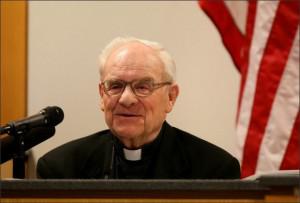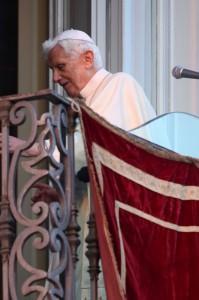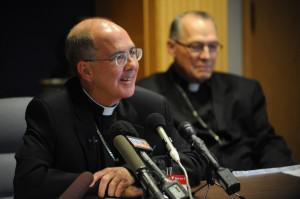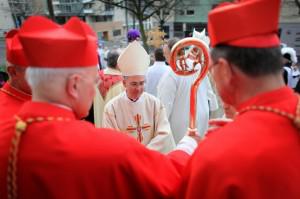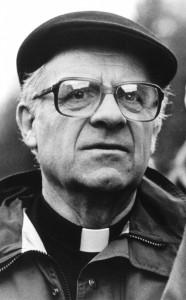|
Kneecapping a Catholic archbishop: The Hunthausen saga remembered
By Joel Connelly
Pope Francis would have enjoyed Seattle Archbishop Raymond Hunthausen, when he moved out of the bishop’s mansion, when he drove his sprawling diocese in an old VW bug, and when he preached a guileless Gospel. The problem for Hunthausen came in that he embodied the reformist Second Vatican Council at a time (the 1980′s) when icy, careerist authoritarians were reasserting top-down control of the Roman Catholic Church.
In John McCoy’s excellent new book, “A Still and Quiet Conscience: The Archbishop Who Challenged a Pope, a President and a Church” (Orbis Books, $26), clashing views of Catholicism are captured in conversation. Authoritarian Cardinal Josef Ratzinger rebukes Hunthausen for allowing the gay Catholic group Dignity to use St. James Cathedral. The Seattle archbishop replies by evoking John 8:11 in which the Pharisees bring to Jesus a woman caught in adultery and demand that she be stoned to death. Fireworks follow: “Hunthausen was recounting the Gospel story when Ratzinger, his voice full of wrath, interrupted him. ‘Are you presuming to lecture me?’” he demanded. “The archbishop paused, caught his breath and quietly continued. In regard to Dignity, he explained, ‘I tried to do what I thought Jesus would do. Jesus didn’t wait until people changed before he talked to them. He began a dialogue and I think that’s what they church ought to do with the gay community.’ “Infuriated, Ratzinger silenced him again. ‘Don’t preach to me,’” he said. Ratzinger would go on to be Pope Benedict XVI, but the future Holy Father comes across as a nasty piece of work. The Vatican, under Ratzinger and Pope (now Saint) John Paul II, sought to roll back the collegial church, with its national bishops conferences, lay church councils and inquiring theologians that had emerged from Vatican II. “The Christian fabric must be remade,” John Paul said in his first encyclical. In McCoy’s words, “The two prelates remade that fabric by exercising their authority through an unprecedented campaign of condemnations, interventions, banishments, silencings and excommunications that some commentators compared to the Inquisition.” Theologians were a top target. In the New World, however, U.S. bishops needed to be brought to heel. As well, the Vatican had made a backstage alliance with the Reagan Administration to bring down Communism in Eastern Europe. “The pope and the future pope figures that making an example of one U.S. bishop … would bring the others in line,” McCoy wrote. “Investigate, embarrass and punish one bishop, and others will mend their ways.” The author marshals an abundance of evidence in support of his thesis. Hunthausen was picked because he delegated authority, reached out to those condemned by Rome … and because he was a pacifist, active in protests against the Trident nuclear sub, who had infuriated the Reagan administration. “The Vatican would accomplish its purpose,” McCoy adds. “Bring the U.S. bishops to heel without a great deal of fuss and consternation. Hunthausen was perfect. Or so Rome thought.” The Holy See committed a massive clerical error. Hunthausen was a Montana priest and college teacher. He had never studied in Rome, never been exposed to the Curia’s cutthroat culture. He was not well connected. His diocese was in an “unchurched” corner of America. He was a loyalist who could be expected to fall in line. The Holy See put Hunthausen through a modern version of the thumbscrews and hot tar. The inquisition was called a “visitation”, conducted by a “formal, austere” archbishop who was an influential church insider. The visitation produced a critical report which Hunthausen was not allowed to see. He was stripped of pastoral authority in five he areas. The authority was given over to an auxiliary bishop, trained in Rome and marked for advancement. What Rome did not recognize was the backbone of “Dutch” Hunthausen. Nor did political careerists in purple and red hats appreciate his powers of conscience. McCoy reports on the uncomfortable arrival of the Vatican’s minder, Bishop Donald Wuerl, in informal, inclusive Seattle. Wuerl was, writes McCoy, a product of the “prescribed, closed, subservient Catholic culture he knew from Pittsburgh and Rome. ” First, Wuerl had to be dissuaded from occupying posh digs downtown in the Watermark Tower. Then at Pentecost, he and Hunthausen were slated to concelebrate a mass in the gymnasium of Kennedy High School. Wuerl called a priest into his room “to reveal a stunningly gorgeous miter embroidered with gold images of saints,” writes McCoy. “It must have cost $1,000. ‘I’m going to wear this for the first time today,’ said Wuerl, beaming with pleasure.” Quietly, the priest told Wuerl that he best wear “the plain white one” because that is what Hunthausen would be wearing. Hunthausen refused to buckle. He refused to sign off on “errors” in ministry. At key times, he insisted that Vatican letters be made public. The Vatican learned, as news of its crackdown spread, that American Catholics are neither disciplined nor docile. Diocesan priests, women religious, lay people and the National Federation of Priests Councils rallied to Hunthausen’s defense. A Rome-trained priest (and Wuerl seminary classmate), Father Michael Ryan, sacrificed his future in the episcopate to coordinate defense of a holy innocent. Great figures in American Catholicism buttressed Hunthausen. “You are my ideal of the best kind of archbishop, courageous, idealistic, dedicated, fearless and most of all, unambitious,” wrote Father Theodore Hesburgh, president of the University of Notre Dame. What were the problems with Hunthausen? He was accused of such “errors” as letting kids receive communion without a priest hearing their first confession. He was condemned for allowing former priests and spouses back into the lives of their parishes. He was blamed for instances of intercommunion with Protestants. In the Vatican’s eyes, that was a “scandal.” How monumentally absurd it seems, when conservative hierarchs (e.g. Cardinal Bernard Law of Boston) were transferring “problem” abuser priests from parish to parish. The Vatican was eventually forced to back off, but not back down. Wuerl was sent back to Pittsburgh, soon to become the city’s bishop. He is today the cardinal-archbishop of Washington, D.C. As a more amenable match, affable Montana Bishop Thomas Murphy was brought in to share power with Hunthausen. The cohabitation was uneasy. One man was orthodox on internal church matters. The other wanted an inclusive church. Hunthausen chose to retire on August 21, 1991, his 70th birthday. The normal mandatory retirement age for bishops is seventy-five. Why care of such events? Hunthausen was an early model for Francis’ ministry. We now have a pope who, when asked about gay priests, replied: “Who am I to judge?” Francis has washed the feet of women prisoners on Holy Thursday. He drives an old Renault sedan. He is readying an encyclical on climate change. “Francis is doing the things I tried to do,” Hunthausen, now in his 90′s and retired back home in Montana, tells McCoy. The laity, even many non-Catholics, have rallied to the Gospel-living pope. McCoy’s book has one shortcoming, likely with diplomatic roots. He should have delved more into Hunthausen’s lasting legacy among Catholics here. They have refused to knuckle under to his remote, often discipline-driven successors. In 2012, Archbishop J. Peter Sartain asked parishes to serve and collection and distribution points for petitions for a referendum to roll back same-sex marriage. Several parishes, including St. James Cathedral, refused. The pastor at St. Joseph Church warned of division and hurt. A crowd of 500 “Catholics for Marriage Equality” rallied at St. James Cathedral just before election day. Successor archbishops have curbed formal ecumenical cooperation. So what. Catholic pastors and lay people were a big part of the faith coalition that pushed and passed a gun background check coalition. The Vatican put Sartain in charge of an “apostolic visitation” with the task of cracking down on America’s nuns. Hundreds marched and rallied at the cathedral bearing signs and buttons saying, “I Stand with the Sisters.” Hunthausen remains a prophet without honor in the Catholic hierarchy. Bishops and chancery insiders were conspicuously absent when he was honored by the Washington Association of Churches. He was almost written out of a Catholic Northwest Progress issue marking the 50th anniversary of Vatican II. The picture in the pews is different. St/ James Cathedral unveiled a statue of Pope (now Saint) John XXIII (who called the Vatican Council) a couple years back, with Hunthausen and his priest-brother Jack in attendance. The cathedral was packed with more than 1,200 worshipers. When Ryan, pastor at St. James, introduced Hunthausen, the standing ovation went on for minutes. Afterward, as old friends greeted him, Hunthausen had precise, often funny memories of times spent together. The message of his ministry: The Church needs fewer icy careerists and more guileless preachers of the Gospels … even if they afflict the comfortable.
|
.
Any original material on these pages is copyright © BishopAccountability.org 2004. Reproduce freely with attribution.
